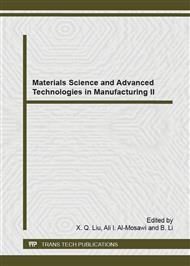p.132
p.138
p.142
p.146
p.151
p.156
p.161
p.165
p.171
Using Supercritical CO2 as an Assistant Method to Optimize the Permeability and Fixation of Nano-TiO2 in PP Non-Woven
Abstract:
In order to solve the difficulty of how nanoTiO2 could penetrate and fixate in polypropylene fiber, the study was carried out by using supercritical CO2 as an assistant method. According to the experiments, the stable nanoTiO2 dispersion could be obtained by the following process. Mixed nanoTiO2, penetrant JFC, polyethylene glycol and ethanol together under the mass ratio of 10:2:1:600, adjusted the pH value to 11, and ultrasonic dispersed for 30mins. Then the PP non-woven fabric was immersed in this solution for 10mins, followed by the treatment with the assistance of supercritical CO2. The optimum process was achieved after three single factor experiments. The reaction time was 40mins, pressure was 30MPa and temperature was 100°C. After treatment, the content of nanoTiO2 in 100g PP non-woven fabric could reach 4.43g, the percentage of the washed residue was 3.42g and the loss rate was 26.3%. nanoTiO2 could penetrate and fixate very well in PP fiber.
Info:
Periodical:
Pages:
151-155
Citation:
Online since:
December 2014
Authors:
Keywords:
Price:
Сopyright:
© 2015 Trans Tech Publications Ltd. All Rights Reserved
Share:
Citation:


